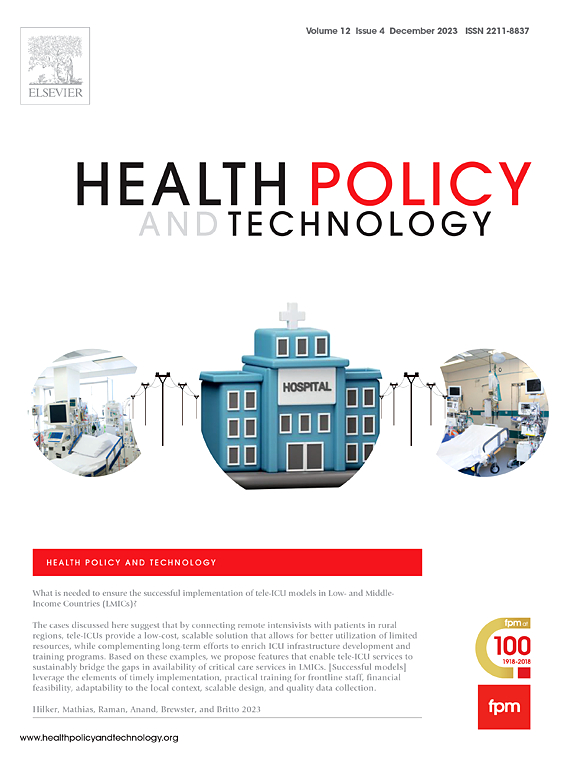The impact of the cancer control equity policy for cancer care on social burdens
IF 3.7
3区 医学
Q1 HEALTH POLICY & SERVICES
引用次数: 0
Abstract
Objectives
Cancer is the leading cause of death in Japan, and various cancer control policies have been implemented since the 1960s. The Cancer Control Act, enacted in 2006, states that the promotion of equity in cancer care is a fundamental principle. However, there has been no evaluation of whether the government's cancer-related policies have promoted equity. In this study, we evaluated whether equity in cancer care has progressed using the cost of illness (COI) method.
Methods
We estimated the COI from 2008 to 2020 by summing the direct, morbidity and mortality costs for each secondary medical area set to complete general hospitalization care. By measuring the coefficient of variation for each cost, we observed variation trends by categorizing secondary medical areas into urban or rural areas.
Results
The variation in morbidity costs, which is thought to directly reflect policy, decreased significantly from 2008 to 2020 (0.245→0.221). However, the variation in mortality costs increased (0.171→0.189), and there was no statistically significant trend in COI overall. The increase in COI was lower in urban secondary medical areas than in rural secondary medical areas. Due to differences in the age structure of the population between rural and urban secondary medical areas and the more pronounced effectiveness of cancer treatment in younger individuals, the analysis using COI revealed a reduction in disparities in access to cancer care; however, this did not lead to the verification of these disparities within the COI framework.
癌症防治公平政策对癌症护理社会负担的影响
癌症是日本的主要死亡原因,自20世纪60年代以来,日本实施了各种癌症控制政策。2006年颁布的《癌症控制法》规定,促进癌症治疗的公平性是一项基本原则。然而,目前还没有评估政府的癌症相关政策是否促进了公平。在这项研究中,我们使用疾病成本(COI)方法评估癌症治疗的公平性是否取得了进展。方法对2008 ~ 2020年各二级医疗区为完成普通住院治疗而设置的直接费用、发病费用和死亡费用进行估算。通过测量各项费用的变异系数,我们观察了二级医疗区域按城市和农村划分的变化趋势。结果从2008年到2020年,被认为直接反映政策的发病率成本变化明显下降(0.245→0.221)。但死亡成本的变化幅度增大(0.171→0.189),总体COI变化趋势无统计学意义。城市二级医疗区COI的增幅低于农村二级医疗区。由于农村和城市二级医疗地区人口年龄结构的差异,以及癌症治疗对年轻人的有效性更为显著,利用COI进行的分析显示,获得癌症治疗方面的差距有所缩小;但是,这并没有导致在调查委员会框架内核查这些差异。
本文章由计算机程序翻译,如有差异,请以英文原文为准。
求助全文
约1分钟内获得全文
求助全文
来源期刊

Health Policy and Technology
Medicine-Health Policy
CiteScore
9.20
自引率
3.30%
发文量
78
审稿时长
88 days
期刊介绍:
Health Policy and Technology (HPT), is the official journal of the Fellowship of Postgraduate Medicine (FPM), a cross-disciplinary journal, which focuses on past, present and future health policy and the role of technology in clinical and non-clinical national and international health environments.
HPT provides a further excellent way for the FPM to continue to make important national and international contributions to development of policy and practice within medicine and related disciplines. The aim of HPT is to publish relevant, timely and accessible articles and commentaries to support policy-makers, health professionals, health technology providers, patient groups and academia interested in health policy and technology.
Topics covered by HPT will include:
- Health technology, including drug discovery, diagnostics, medicines, devices, therapeutic delivery and eHealth systems
- Cross-national comparisons on health policy using evidence-based approaches
- National studies on health policy to determine the outcomes of technology-driven initiatives
- Cross-border eHealth including health tourism
- The digital divide in mobility, access and affordability of healthcare
- Health technology assessment (HTA) methods and tools for evaluating the effectiveness of clinical and non-clinical health technologies
- Health and eHealth indicators and benchmarks (measure/metrics) for understanding the adoption and diffusion of health technologies
- Health and eHealth models and frameworks to support policy-makers and other stakeholders in decision-making
- Stakeholder engagement with health technologies (clinical and patient/citizen buy-in)
- Regulation and health economics
 求助内容:
求助内容: 应助结果提醒方式:
应助结果提醒方式:


